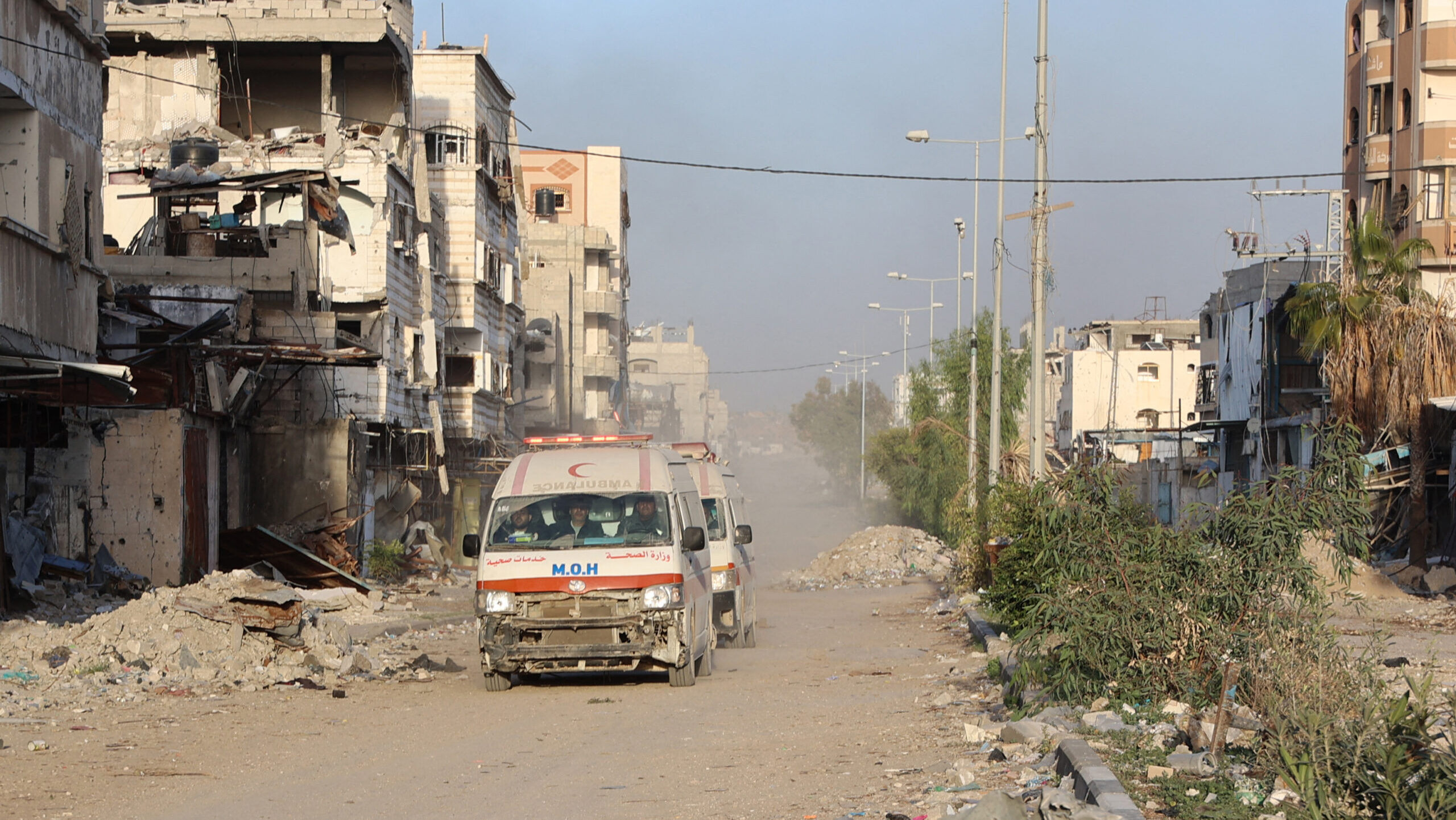Analysis: Israel-Hamas War Tests Ethics Surrounding Combat and Care
While Israel cites Hamas' misuse of medical facilities for military purposes, Gaza's health system struggles under dire conditions, raising questions about proportionality and international law
Since the war between Israel and Hamas began, the lines between health and conflict have blurred.
Israel accuses Hamas of using hospitals as military bases and hiding among civilians. At the same time, the people of Gaza face the collapse of their healthcare system as hospitals and medical facilities are damaged or destroyed in Israel’s efforts to eliminate the terror group.
While Israel, unlike a terror organization, is required to uphold international law regardless of the actions of the opposing side, the rules of proportionality are open to interpretation, experts say—particularly as more is understood about the dire situation of the Israeli hostages held by Hamas.
Hostages in Hamas captivity: ‘Unfathomable acts of horror’
Earlier this week, the Israeli Health Ministry released a report presented to the United Nations detailing the neglect, abuse, torture, and humiliation endured by hostages who were released or rescued from captivity in Gaza. The report also highlighted the devastating effects of these experiences on their physical and mental health.
Health Minister Uriel Busso described the report as evidence of “the brutal experiences suffered by the hostages in Hamas captivity—cruel violence, psychological abuse, physical torment, and unfathomable acts of horror.” He called on the international community to pressure Hamas to release the hostages; even the International Red Cross has been unable to access them or provide basic medical care in the Gaza Strip despite its role as a neutral intermediary.
Not a day passes without my thoughts being with the immense hardships faced by those who have been released and those still held in captivity. The severe physical and mental states of the released hostages provide the world with a glimpse into the widespread atrocities committed by Hamas. Based on the testimonies we have received, I can confidently state that the physical and mental condition of all hostages still held in Gaza is dire.
“Not a day passes without my thoughts being with the immense hardships faced by those who have been released and those still held in captivity,” said Dr. Hagar Mizrahi, head of the Medical Directorate of the Health Ministry. “The severe physical and mental states of the released hostages provide the world with a glimpse into the widespread atrocities committed by Hamas. Based on the testimonies we have received, I can confidently state that the physical and mental condition of all hostages still held in Gaza is dire.”
One hundred Israelis remain held hostage in Gaza, with at least a third believed to be alive. As of Wednesday, negotiations for their release appeared to have stalled once again.
Hospitals under fire
Meanwhile, the health crisis facing the people of Gaza has received significant attention from the World Health Organization (WHO) and international media.
Most recently, on Friday, Israeli forces carried out a raid on Kamal Adwan Hospital in the northern town of Beit Lahia. The raid reportedly caused extensive damage to the facility and forced patients and displaced civilians to flee.
The IDF reported that during the operation, it apprehended 240 terrorists operating out of the hospital, including 15 who were involved in the October 7 massacre in Israel. The army also claimed that its forces safely evacuated civilians from the area around the hospital.
The area near the hospital is an active combat zone and rigged by terrorists with booby traps and explosives. During the operation, approximately 20 terrorists were eliminated, and powerful explosive devices planted by the terrorists were neutralized.
“The area near the hospital is an active combat zone and rigged by terrorists with booby traps and explosives,” the IDF stated. “During the operation, approximately 20 terrorists were eliminated, and powerful explosive devices planted by the terrorists were neutralized.”
The IDF added that the captured terrorists are expected to provide valuable intelligence for ongoing war efforts. Moreover, the IDF said that the hospital was being used as a “command and control center.”
This holiday season, give to:
Truth and understanding
The Media Line's intrepid correspondents are in Israel, Gaza, Lebanon, Syria and Pakistan providing first-person reporting.
They all said they cover it.
We see it.
We report with just one agenda: the truth.


This is one of the largest operations to apprehend terrorists conducted in a single location since the beginning of the war. Several terrorists attempted to pose as patients, with some even hiding in ambulances. However, they were identified by IDF soldiers and apprehended.
“This is one of the largest operations to apprehend terrorists conducted in a single location since the beginning of the war,” the army said. “Several terrorists attempted to pose as patients, with some even hiding in ambulances. However, they were identified by IDF soldiers and apprehended.”
Over the weekend, WHO issued a statement expressing its outrage over the raid on Kamal Adwan Hospital, which it described as “putting the last major health facility in North Gaza out of service.”
WHO further stated that the “systematic dismantling of the health system and a siege for over 80 days on North Gaza puts the lives of the 75,000 Palestinians remaining in the area at risk.”
Patients and staff who the IDF did not detain were directed to evacuate to the nearby Indonesian Hospital, which WHO noted had also been targeted by Israel and is severely lacking in supplies and infrastructure.
Meanwhile, the IDF confirmed the arrest of Kamal Adwan Hospital’s director, Dr. Hussam Abu Safiya, citing his ties to Hamas. Despite the allegations, WHO Director-General Tedros Adhanom Ghebreyesus called for Abu Safiya’s immediate release.
“Hospitals in Gaza have once again become battlegrounds, and the health system is under severe threat,” Dr. Tedros posted on X. “We repeat: stop attacks on hospitals. People in Gaza need access to health care. Humanitarians need access to provide health aid. Ceasefire!”
Amnesty International also weighed in, describing Abu Safiya as “the voice of Gaza’s decimated health sector.” However, open sources suggest that the IDF’s claims may be accurate.
Independent researcher Eitan Fischberger told The Media Line that Abu Safiya is referred to as a “colonel” within Hamas.
Additional evidence that Fischberger shared includes a video from earlier this year in which a Kurdish doctor who volunteered at the hospital stated, “I have seen it with my eyes that the hospitals have been used for hiding Hamas leaders… we saw them and even spoke with them.”
Kamal Adwan Hospital is classified as a military hospital, operating under Hamas’s Military Medical Services Directorate rather than the Hamas-run Health Ministry. This distinction was confirmed in a December 2023 CNN article and is visible in photos shared on social media by the hospital. One 2016 photo shows the opening of the hospital complex, describing it as “equipped to serve military personnel in the Ministry of Interior and National Security.” Other images depict Hamas operatives in uniform celebrating at the facility.
A December report by The Times of Israel cited an interrogation of the hospital’s previous director, Ahmed Kahlot, conducted by the Shin Bet and IDF. Kahlot revealed that Hamas officers operated within the hospital and used it as a base for operational activities. He also disclosed that more than a dozen hospital staff members—including doctors, nurses, and paramedics—were Hamas operatives. Others were affiliated with the Palestinian Islamic Jihad’s Al-Quds Brigades.
Kahlot’s testimony aligns with the IDF’s assertion that hospitals in Gaza are being used for military purposes rather than solely providing medical care.
When The Media Line sought clarification from WHO, the organization reiterated its stance under International Humanitarian Law (IHL). “Healthcare workers and healthcare facilities are off limits. They must not be attacked. They must not be used for military purposes. They must be protected at all times,” WHO stated in an email to The Media Line.
It emphasized that violations of IHL cause harm twice: first in the immediate impact and later in the long-term damage to health systems. Even when combatants misuse health facilities, WHO noted, “there are stringent conditions which apply to taking action against them, including a duty to warn and to wait after warning. Disproportionate attacks are strictly prohibited.”
Since October 2024, WHO has confirmed at least 50 attacks targeting health facilities in or around Kamal Adwan Hospital. Despite the growing demand for emergency and trauma care, only 10 out of 21 WHO missions to the hospital have been partially completed between October and December. These missions delivered 45,000 liters of fuel, medical supplies, blood, and food and facilitated the transfer of 114 patients and 123 companions to Al-Shifa Hospital. However, WHO said, requests to deploy international emergency medical teams have consistently been denied.
Guy Shalev, executive director of Physicians for Human Rights Israel, told The Media Line that he is in constant communication with hospital directors, doctors and nursing professionals on the ground in Gaza who “validate” what WHO is depicting.
Shalev added that 25,000 people are waiting to be evacuated from Gaza to get treatments no longer available in the strip but that they cannot leave the enclave because Israel has not permitted them.
“Since Israel took over the Rafah border [with Egypt] in May 2024, only 380 patients have left,” Shalev claimed. “It is absurd. There is not even a question in terms of international humanitarian law. Israel is obligated to allow these people out to get medical treatment.”
Shalev added that there is a lack of food and other necessities in northern Gaza, forcing residents out of the region, which he equated to “ethnic cleansing.”
A different perspective: Israel’s ‘proactive’ measures
Israel, however, views the situation differently.
The Coordination of Government Activities in the Territories (COGAT) told The Media Line that since the war began, approximately 63,171 aid trucks carrying around 1,257,325 tons of humanitarian aid have entered the Gaza Strip through various crossings. This includes nearly a million tons of food, 52,580 tons of water, 29,746 tons of medical supplies, and 97,535 tons of shelter equipment.
Nearly 3,000 trucks delivered the medical supplies. Additionally, 13 field hospitals have been established across Gaza alongside existing operational hospitals. According to COGAT, 22 operational hospitals are currently providing dedicated medical care to Gaza’s residents. To further enhance the medical response, more than 130 ambulances have also been provided to international organizations.
The State of Israel is actively working, including through proactive measures, to allow and facilitate the transfer of as much aid as possible to the Gaza Strip without any quantitative limitations. This effort is coordinated with the United States, Egypt, the United Nations, and international aid organizations, maintaining continuous and regular contact with organizations operating in the strip and demonstrating a commitment to allowing and facilitating an effective humanitarian response for the civilian population in the area.
“The State of Israel is actively working, including through proactive measures, to allow and facilitate the transfer of as much aid as possible to the Gaza Strip without any quantitative limitations,” a COGAT spokesperson said. “This effort is coordinated with the United States, Egypt, the United Nations, and international aid organizations, maintaining continuous and regular contact with organizations operating in the strip and demonstrating a commitment to allowing and facilitating an effective humanitarian response for the civilian population in the area.”
COGAT also highlighted “movement coordination activities” conducted daily to ensure that aid reaches the intended recipients, including hospitals.
“The IDF, through COGAT, maintains continuous contact with the local health establishment and international aid organizations to deliver supplies, fuel, medical equipment, food, and dual-use equipment such as generators and oxygen tanks to hospitals in the strip,” the spokesperson added. “For example, in recent months, dozens of supply coordination activities have been conducted. These included delivering tens of thousands of liters of fuel, thousands of food packages, water, and medical supplies to hospitals in northern Gaza, such as Kamal Adwan, Al-Awda, and the Indonesian Hospital. These supplies have reportedly reached their destinations.”
COGAT also reported different evacuation figures than those cited by other sources. According to COGAT, 22 missions have evacuated 928 patients and their escorts through Israeli sovereign territory. Additionally, many different patients and wounded individuals reportedly left for Egypt at the beginning of the war, according to Israeli knowledge.
As the war rages on, the truth about the use of hospitals, the effectiveness of humanitarian aid, and the proportionality of military actions remains clouded by the fog of war.
It is likely that only once the conflict ends will the full story emerge—revealing not only the extent to which Hamas exploited its health facilities and the well-being of its people to wage war against Israel but also whether Israel acted justly in its treatment of the civilians who suffer under Hamas’s rule.
Until then, these competing narratives will continue to dominate.

